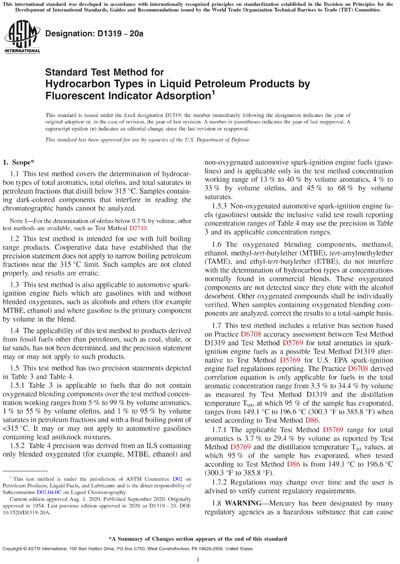Most recent
ASTM D1319-20a
Standard Test Method for Hydrocarbon Types in Liquid Petroleum Products by Fluorescent Indicator Adsorption
1.1 This test method covers the determination of hydrocarbon types of total aromatics, total olefins, and total saturates in petroleum fractions that distill below 315 °C. Samples containing dark-colored components that interfere in reading the chromatographic bands cannot be analyzed.
Note 1: For the determination of olefins below 0.3 % by volume, other test methods are available, such as Test Method D2710.
1.2 This test method is intended for use with full boiling range products. Cooperative data have established that the precision statement does not apply to narrow boiling petroleum fractions near the 315 °C limit. Such samples are not eluted properly, and results are erratic.
1.3 This test method is also applicable to automotive spark-ignition engine fuels which are gasolines with and without blended oxygenates, such as alcohols and ethers (for example MTBE, ethanol) and where gasoline is the primary component by volume in the blend.
1.4 The applicability of this test method to products derived from fossil fuels other than petroleum, such as coal, shale, or tar sands, has not been determined, and the precision statement may or may not apply to such products.
1.5 This test method has two precision statements depicted in Table 3 and Table 4.
1.5.1 Table 3 is applicable to fuels that do not contain oxygenated blending components over the test method concentration working ranges from 5 % to 99 % by volume aromatics, 1 % to 55 % by volume olefins, and 1 % to 95 % by volume saturates in petroleum fractions and with a final boiling point of <315 °C. It may or may not apply to automotive gasolines containing lead antiknock mixtures.
1.5.2 Table 4 precision was derived from an ILS containing only blended oxygenated (for example, MTBE, ethanol) and non-oxygenated automotive spark-ignition engine fuels (gasolines) and is applicable only in the test method concentration working range of 13 % to 40 % by volume aromatics, 4 % to 33 % by volume olefins, and 45 % to 68 % by volume saturates.
1.5.3 Non-oxygenated automotive spark-ignition engine fuels (gasolines) outside the inclusive valid test result reporting concentration ranges of Table 4 may use the precision in Table 3 and its applicable concentration ranges.
1.6 The oxygenated blending components, methanol, ethanol, methyl-tert-butylether (MTBE), tert-amylmethylether (TAME), and ethyl-tert-butylether (ETBE), do not interfere with the determination of hydrocarbon types at concentrations normally found in commercial blends. These oxygenated components are not detected since they elute with the alcohol desorbent. Other oxygenated compounds shall be individually verified. When samples containing oxygenated blending components are analyzed, correct the results to a total-sample basis.
1.7 This test method includes a relative bias section based on Practice D6708 accuracy assessment between Test Method D1319 and Test Method D5769 for total aromatics in spark-ignition engine fuels as a possible Test Method D1319 alternative to Test Method D5769 for U.S. EPA spark-ignition engine fuel regulations reporting. The Practice D6708 derived correlation equation is only applicable for fuels in the total aromatic concentration range from 3.3 % to 34.4 % by volume as measured by Test Method D1319 and the distillation temperature T95, at which 95 % of the sample has evaporated, ranges from 149.1 °C to 196.6 °C (300.3 °F to 385.8 °F) when tested according to Test Method D86.
1.7.1 The applicable Test Method D5769 range for total aromatics is 3.7 % to 29.4 % by volume as reported by Test Method D5769 and the distillation temperature T95 values, at which 95 % of the sample has evaporated, when tested according to Test Method D86 is from 149.1 °C to 196.6 °C (300.3 °F to 385.8 °F).
1.7.2 Regulations may change over time and the user is advised to verify current regulatory requirements.
1.8 WARNING—Mercury has been designated by many regulatory agencies as a hazardous substance that can cause serious medical issues. Mercury, or its vapor, has been demonstrated to be hazardous to health and corrosive to materials. Use caution when handling mercury and mercury-containing products. See the applicable product Safety Data Sheet (SDS) for additional information. The potential exists that selling mercury or mercury-containing products, or both, is prohibited by local or national law. Users must determine legality of sales in their location.
1.9 The values stated in SI units are to be regarded as standard. The values given in parentheses after SI units are provided for information only and are not considered standard.
1.10 This standard does not purport to address all of the safety concerns, if any, associated with its use. It is the responsibility of the user of this standard to establish appropriate safety, health, and environmental practices and determine the applicability of regulatory limitations prior to use. For specific warning statements, see Section 7, 8.1, and 10.5.
1.11 This international standard was developed in accordance with internationally recognized principles on standardization established in the Decision on Principles for the Development of International Standards, Guides and Recommendations issued by the World Trade Organization Technical Barriers to Trade (TBT) Committee.
Content Provider
ASTM International [astm]






